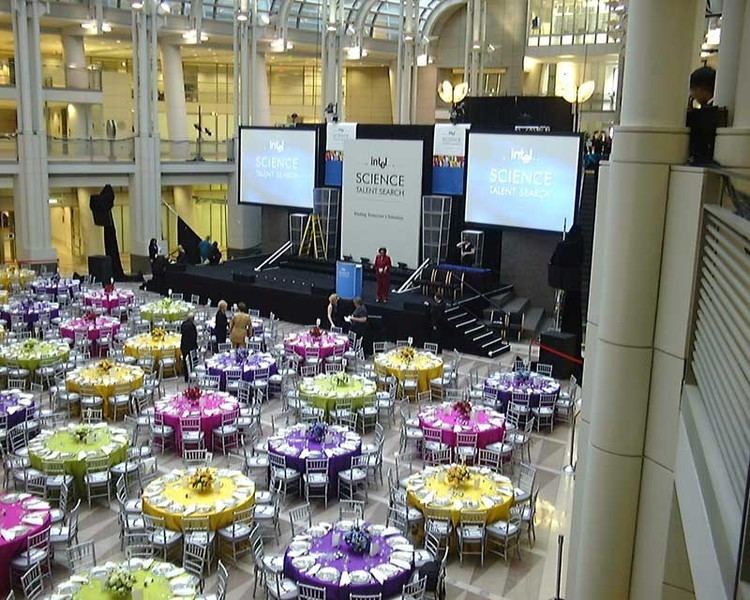 | ||
The Regeneron Science Talent Search, known for its first 57 years as the Westinghouse Science Talent Search, and then as the Intel Science Talent Search from 1998 through 2015, is a research-based science competition in the United States for high school seniors. It has been referred to as "the nation's oldest and most prestigious" science competition. In his speech at the dinner honoring the 1991 Winners, President George H. W. Bush called the competition the "Super Bowl of science."
Contents
History
The Society for Science & the Public began the competition in 1942 with Westinghouse Electric Corporation; for many years, the competition was known as the Westinghouse Science Talent Search. In 1998, Intel became the sponsor after it outbid several other companies. In May 2016, it was announced that Regeneron would be the new title sponsor. Over the years, some 147,000 students have entered the competition. Over 22,000 have been named semifinalists and 2,920 have traveled to Washington, D.C., as contest finalists. Collectively, they have received millions of dollars in scholarships and gone on, in later years, to capture Nobel Prizes, Fields Medals, MacArthur Fellowships and numerous other accolades.
Eight went on to receive Nobel Prizes, two earned the Fields Medal, five have been awarded the National Medal of Science, twelve received MacArthur Fellowships; 56 have been named Sloan Research Fellows; 30 have been elected to the National Academy of Sciences; and five have been elected to the National Academy of Engineering.
Competition
Entrants to the competition conduct original research—sometimes at home and sometimes by "working with leading research teams at universities, hospitals and private laboratories." The selection process is highly competitive, and besides the research paper, letters of recommendation, essays, test scores, extracurricular activities, and high school transcripts may be factored in the selection of finalists and winners.
Each year, approximately 1,800 papers are submitted. The top 300 applicants are announced in mid-January and since 2017 each semifinalist and their school receives $2,000 from the title sponsor. In late January, the 40 Finalists (the award winners) are informed. In March, the Finalists are flown to Washington, D.C. where they are interviewed for the top ten spots, which have awards up to $250,000 for the medal winners. The judges have included Glenn T. Seaborg (Nobel Laureate with Edwin M. McMillan in Chemistry, 1951) and Joseph Hooton Taylor, Jr. (Nobel Laureate in Physics, 1993). All Finalists receive awards of at least $7,500.
Demography
Since the beginning of the competition, students from New York have done very well in the Science Talent Search, although there have been finalists from all 50 states, the District of Columbia, Puerto Rico, and Guam. Certain high schools have been particularly successful at placing semifinalists and finalists in the Science Talent Search.
Top states
New York has had by far the most finalists in the competition, followed by California, Illinois, Pennsylvania, New Jersey, Maryland, Florida, Virginia, Massachusetts, Ohio, and Texas.
Leading high schools in recent era
Reliable online records of the high schools attended by semifinalists and finalists are only available since 1999, when Intel took over sponsorship of the Science Talent Search, although there are newspaper articles naming the finalists from earlier years. In this recent era, several schools have consistently produced a large number of semifinalists and finalists. Montgomery Blair High School in Silver Spring, MD and Stuyvesant High School in New York, NY have produced the most winners over this time period and are the only schools averaging more than 10 semifinalists each year and more than 1 finalist each year.
Ten schools, all of which are public schools (Stuyvesant High School, Montgomery Blair High School, Thomas Jefferson High School for Science and Technology, Ward Melville High School, Bronx High School of Science, Paul D. Schreiber High School, Byram Hills High School, Jericho High School, Great Neck North High School, and Great Neck South High School), have had semifinalists in every year since 1999.
